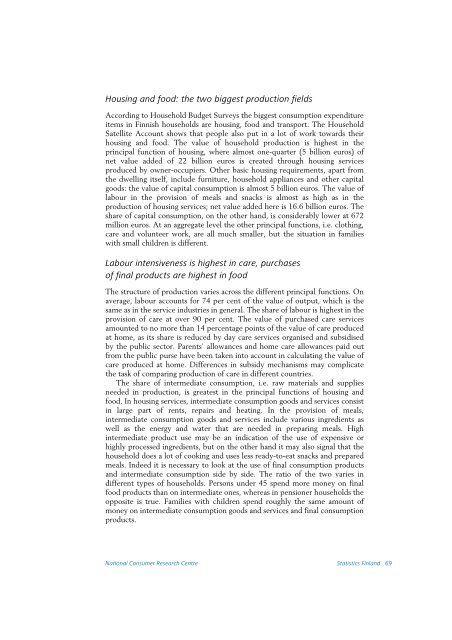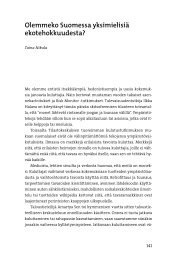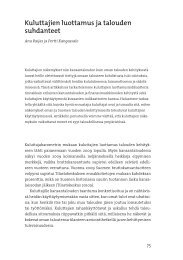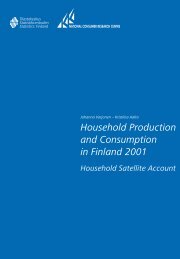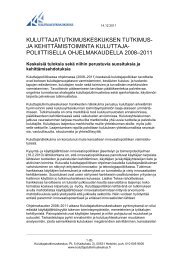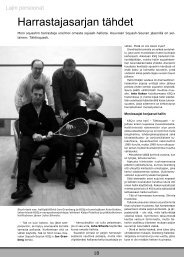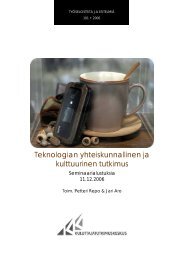Household Production and Consumption in Finland 2001
Household Production and Consumption in Finland 2001
Household Production and Consumption in Finland 2001
Create successful ePaper yourself
Turn your PDF publications into a flip-book with our unique Google optimized e-Paper software.
Hous<strong>in</strong>g <strong>and</strong> food: the two biggest production fields<br />
Accord<strong>in</strong>g to <strong>Household</strong> Budget Surveys the biggest consumption expenditure<br />
items <strong>in</strong> F<strong>in</strong>nish households are hous<strong>in</strong>g, food <strong>and</strong> transport. The <strong>Household</strong><br />
Satellite Account shows that people also put <strong>in</strong> a lot of work towards their<br />
hous<strong>in</strong>g <strong>and</strong> food. The value of household production is highest <strong>in</strong> the<br />
pr<strong>in</strong>cipal function of hous<strong>in</strong>g, where almost one-quarter (5 billion euros) of<br />
net value added of 22 billion euros is created through hous<strong>in</strong>g services<br />
produced by owner-occupiers. Other basic hous<strong>in</strong>g requirements, apart from<br />
the dwell<strong>in</strong>g itself, <strong>in</strong>clude furniture, household appliances <strong>and</strong> other capital<br />
goods: the value of capital consumption is almost 5 billion euros. The value of<br />
labour <strong>in</strong> the provision of meals <strong>and</strong> snacks is almost as high as <strong>in</strong> the<br />
production of hous<strong>in</strong>g services; net value added here is 16.6 billion euros. The<br />
share of capital consumption, on the other h<strong>and</strong>, is considerably lower at 672<br />
million euros. At an aggregate level the other pr<strong>in</strong>cipal functions, i.e. cloth<strong>in</strong>g,<br />
care <strong>and</strong> volunteer work, are all much smaller, but the situation <strong>in</strong> families<br />
with small children is different.<br />
Labour <strong>in</strong>tensiveness is highest <strong>in</strong> care, purchases<br />
of f<strong>in</strong>al products are highest <strong>in</strong> food<br />
The structure of production varies across the different pr<strong>in</strong>cipal functions. On<br />
average, labour accounts for 74 per cent of the value of output, which is the<br />
same as <strong>in</strong> the service <strong>in</strong>dustries <strong>in</strong> general. The share of labour is highest <strong>in</strong> the<br />
provision of care at over 90 per cent. The value of purchased care services<br />
amounted to no more than 14 percentage po<strong>in</strong>ts of the value of care produced<br />
at home, as its share is reduced by day care services organised <strong>and</strong> subsidised<br />
by the public sector. Parents’ allowances <strong>and</strong> home care allowances paid out<br />
from the public purse have been taken <strong>in</strong>to account <strong>in</strong> calculat<strong>in</strong>g the value of<br />
care produced at home. Differences <strong>in</strong> subsidy mechanisms may complicate<br />
the task of compar<strong>in</strong>g production of care <strong>in</strong> different countries.<br />
The share of <strong>in</strong>termediate consumption, i.e. raw materials <strong>and</strong> supplies<br />
needed <strong>in</strong> production, is greatest <strong>in</strong> the pr<strong>in</strong>cipal functions of hous<strong>in</strong>g <strong>and</strong><br />
food. In hous<strong>in</strong>g services, <strong>in</strong>termediate consumption goods <strong>and</strong> services consist<br />
<strong>in</strong> large part of rents, repairs <strong>and</strong> heat<strong>in</strong>g. In the provision of meals,<br />
<strong>in</strong>termediate consumption goods <strong>and</strong> services <strong>in</strong>clude various <strong>in</strong>gredients as<br />
well as the energy <strong>and</strong> water that are needed <strong>in</strong> prepar<strong>in</strong>g meals. High<br />
<strong>in</strong>termediate product use may be an <strong>in</strong>dication of the use of expensive or<br />
highly processed <strong>in</strong>gredients, but on the other h<strong>and</strong> it may also signal that the<br />
household does a lot of cook<strong>in</strong>g <strong>and</strong> uses less ready-to-eat snacks <strong>and</strong> prepared<br />
meals. Indeed it is necessary to look at the use of f<strong>in</strong>al consumption products<br />
<strong>and</strong> <strong>in</strong>termediate consumption side by side. The ratio of the two varies <strong>in</strong><br />
different types of households. Persons under 45 spend more money on f<strong>in</strong>al<br />
food products than on <strong>in</strong>termediate ones, whereas <strong>in</strong> pensioner households the<br />
opposite is true. Families with children spend roughly the same amount of<br />
money on <strong>in</strong>termediate consumption goods <strong>and</strong> services <strong>and</strong> f<strong>in</strong>al consumption<br />
products.<br />
National Consumer Research Centre Statistics F<strong>in</strong>l<strong>and</strong> 69


